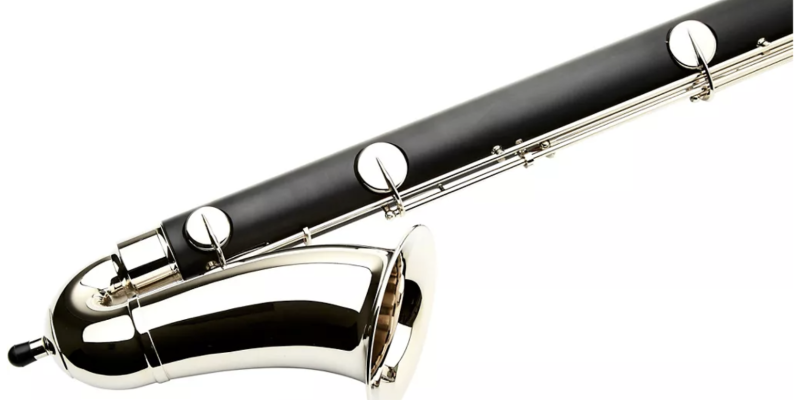
Have you ever seen a clarinet that's over 8 feet tall? Most have never had the pleasure. Sadly but understandably, they are underused in symphony orchestras these days.
This clarinet is a single-reed wind instrument (AKA an aerophone), and it's one of the largest members of the clarinet family that are somewhat in common usage.
This instrument is pitched two octaves lower than soprano clarinets at Bb.
Its practical range falls between a low Eb below the treble staff and a high C above the treble staff (instrumentalists always use a treble clef when playing this instrument). As you can imagine, it has a beautifully rich, superbly smooth tone!
There's a lot of mystery around the conception of this marvelous instrument. The earliest known contrabass clarinet was named the "contre-basse guerrière" and was invented in 1808 by Dumas of Sommières.
Another variation called the "batyphone" was invented by W. F. Wieprecht years later, in 1839. In 1889, Fontaine-Besson started manufacturing a similar instrument called the pedal clarinet.
No matter what this instrument is called, it is very hard to catch in a live performance!
A lot of people get these two instruments confused. The contra-alto clarinet is pitched higher than the contrabass in the key of Eb instead of Bb.
It's seen much more than the contrabass since it's often used in clarinet choirs and ensembles of clarinets and saxophones. Some like to use it for jazz selections and in broadway settings.
To make things even more confusing, both the contrabass and contralto clarinets sound a lot like the bass clarinet. The bass plays notes an octave below the soprano Bb clarinet and an octave above the contrabass clarinet.
This instrument is regularly used in orchestras and bands, so you've probably seen one before. They are definitely much smaller than a contrabass, though!
The octocontra-alto and octocontrabass clarinet are two reed instruments that are larger and lower than the contrabass.
Since you can rarely find a contrabass, you'd have an even harder time finding one of these two more experimental types of creations.
Word has it that only one of each even exists. The octocontra-alto is an octave below the contra-alto clarinet, while the octocontrabass is an octave below the contrabass clarinet.
Related Post: What Instrument Should You Play? Several Choices That May Fit Your Style
This instrument is a rare find, so you can imagine that it would be pretty expensive. You can find new contrabass clarinets for anywhere from $5000 to $15,000 or used ones for around $2000 to $3000.
Instrumentalists like the talented fellow in the video above have been able to find quality instruments on sites like eBay.
Anthony Braxton is the most widely-known musician who plays the contrabass clarinet as a solo instrument. But, he's a multi-instrumentalist that is best known for playing the alto saxophone.
The late LeRoi Moore was also a multi-instrumentalist that played the contrabass clarinet, bass, baritone, tenor, alto, and soprano saxophones. Along with the Dave Matthews Band, he played a contrabass clarinet on the popular song "So Right".
Other notable names include Colin Stetson, Mwata Bowden, Jason Alde, Brian Landrus, Paolo Ravaglia, and jazz musician James Carter.
The contrabass clarinet is a less commonly used instrument in popular music compared to the regular clarinet, but there are still a few examples where it has been utilized. Here are some factual examples of the contrabass clarinet being used in popular songs:
"Good Vibrations" by The Beach Boys: In this iconic song, the contrabass clarinet was used to create the distinctive and unique bassline that adds depth and richness to the composition.
"So Right" by Dave Matthews Band: On the 2001 album "Everyday," the contrabass clarinet is featured in the song "So Right," adding a deep and resonant bassline to the composition.
John Linnell of They Might Be Giants: John Linnell, one half of the duo They Might Be Giants, has utilized the contra-alto clarinet on their 2013 album "Nanobots" and subsequent releases.
Related Post: 8 Ideas For Naming Your Music Instrument

As a session singer, writer, and producer that has worked with over 300 clients to provide high-quality jingles, singles, and features, Yona spends her time creating and marketing new music and helpful resources for creators. Check out Yona’s latest releases on her Spotify, her Youtube and share if you like it!
If you are in need of singer, songwriter or song producer services, see what Yona Marie can offer you on her services page.